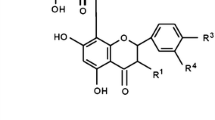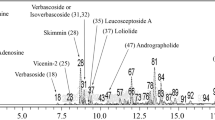Abstract
Increasing evidence supports the role of excitotoxicity in neuronal cell injury. Thus, it is extremely important to explore methods to retard or reverse excitotoxic neuronal injury. In this regard, certain dietary compounds are begining to receive increased attention, in particular those involving phytochemicals found in medicinal plants in alleviating neuronal injury. In the present study, we examined whether medicinal plant extracts protect neurons against excitotoxic lesions induced by kainic acid (KA) in female Swiss albino mice. Mice were anesthetized with ketamine and xylazine (200 mg and 2 mg/kg body wt. respectively) and KA (0.25 μg in a volume of 0.5 μ1) was administered to mice by intra hippocampal injections. The results showed an impairment of the hippocampus region of brain after KA injection. The lipid peroxidation and protein carbonyl content were significantly(P 005) increased in comparison to controls. Glutathione peroxidase (GPx) activity (EC 1.11-1.9) and reduced glutathione (GSH) content declined after appearance of excitotoxic lesions. As GPx and GSH represent a major pathway in the cell for metabolizing hydrogen peroxide (H2O2), their depletion would be expected to allow H2O2 to accumulate to toxic levels. Dried ethanolic plant extracts ofWithania somnifera (WS),Convolvulus pleuricauas (CP) andAloe vera (AV) dissolved in distilled water were tested for their total antioxidant activity. The diet was prepared in terms of total antioxidant activity of plant extracts. The iron (Fe3+) reducing activity of plant extracts was also tested and it was found that WS and AV were potent reductants of Fe3+ at pH 5.5. CP had lower Fe3+ reducing activity in comparison to WS and AV. Plant extracts given singly and in combination 3 weeks prior to KA injections resulted in a decrease in neurotoxicity. Measures of lipid peroxidation and protein carbonyl declined. GPx activity and GSH content were elevated in hippocampus supplemented with WS and combination of WS + CP + AV. However, when CP and AV were given alone, the changes in the GPx activity and GSH content were not significant. Although the major factors involved in these properties of phytochemicals remain to be specified, the finding of this study has suggested that phytochemicals present in plant extracts mitigate the effects of excitotoxicity and oxidative damage in hippocampus and this might be accomplished by their antioxidative properties.
Similar content being viewed by others
Abbreviations
- AV:
-
Aloe vera
- CP:
-
Convolvulus pleuricauas
- DNPH:
-
2,4-dinitrophenyl hydrazine
- FRAP:
-
ferric reducing/antioxidant power
- GPx:
-
glutathione peroxidase
- GSH:
-
glutathione
- KA:
-
kainic acid
- MDA:
-
malonaldehyde equivalent
- O2.:
-
superoxide radical
- WS:
-
Withania somnifera
References
Aksenov M Y, Butterfield D A, Geddes J W and Markesbery W R 2001 Protein oxidation in the brain in Alzheimer’s disease;Neuroscience 103 373–383
Bardgett M E and Henry J D 1999 Locomotor activity and accumbensfos expression driven by ventral hippocampal stimulation require D1 and D2 receptors;Neuro science 94 59–70
Beal M F 1995 Aging, energy and oxidative stress in neurodegenerative diseases;Ann. Neurol. 38357–366
Beal M F 1997 Oxidative damage in neurodegenerative diseases;Neuros cientist 321–27
Benzi G and Moretti A 1995 Are reactive oxygen species involved in Alzheimer’s disease?;Neurobiol. Aging 16 661–674
Benzie IFF and Strain J J 1999 Ferric reducing/antioxidant power assay: direct measure of total antioxidant activity of biological fluids and modified version for simultaneous measurement of total antioxidant power and ascorbic acid concentration;Methods Enzymol. 299 15–34
Bindokas V P, Jordan J, Lee C C and Miller R J 1996 Superoxide production in rat hippocampal neurons: selective imaging with hydroethidine;J. Neurosci. 16 1324–1336
Bondy S C 1997 Neurotoxicant induced oxidative events in the nervous system; inComprehensive toxicology (eds) G Sipes, C A McQueen and A J Gandolfi (London: Pergamon Press) pp 59–72
Boyer R F, Clark H M and LaRoche A P 1988 Reduction and release of ferritin iron by plant phenolics;J. Inorg. Biochem. 32 171–181
Cheesman K H and Slater T F 1993 An introduction to free radical biochemistry;Br. Med. Bull. 49 481–493
Coyle J T and Puttfarcken P 1993 Oxidative stress, glutamate and neurodegenerative disorders;Science 262 689–695
Culmsee C, Bondada S and Mattson M P 2001 Hippocampal neurons of mice defficient in DNA-dependent protein kinase exhibit increased vulnerability to DNA damage, oxidative stress and excitotoxicity;Mol. Brain Res. 87 257–262
Demizu S, Kajiyama K, Takahashi K, Hiraga Y, Yamamoto S, Tamura Y, Okada K and Kinoshita T 1988 Antioxidant and antimicrobial constituents of licorice: Isolation and structure elucidation of a new benzofuran derivative;Chem. Pharm. Bull. 36 3474–3479
Halder J and Bhaduri A N 1998 Protective role of black tea against oxidative damage of human red blood cells;Biochem. Biophys. Res. Commun. 244 903–907
Hantraye P, Brouillet Ferrante R, Palfi S, Dolan R, Mathews R T and Beal M F 1996 Inhibition of neuronal nitric oxide synthase prevents MPTP-induced Parkinsonism in baboons;Nature Med. 2 1017–1021
Hemnani T and Parihar M S 1999 An attempt to bypass the bioenergetic defects and oxidative stress in tert-butyl hydroperoxide induced neurotoxicity by pretreatment with a combination of compounds in mice: implications in neurodegenerative disorders; inFree radicals and antioxidants (eds) P P Singh, A K Pendse, B SBomb, M K Barjatiya and R Ghosh (Udaipur: Choudhary Offset Pvt. Ltd) pp 199–205
Hong J T, Ryu S R, Kim H J, Lee J K, Lee S H, Kim D B, Yun Y P, Ryu J H, Lee B M and Kim P Y 2000 Neuroprotective effect of green tea extract in experimental ischemia-reperfusion brain injury;Brain Res. Bull. 53 743–749
Jollow D J, Mitchell J R, Zampaglione Y and Gillette J R 1974 Bromobenzene induced liver necrosis, protective role of glutathione and evidence for 3, 4-bromobenzene oxide as the toxic metabolite;Pharmacology 11 151–169
Joseph J A, Shukitt-Hale B, Denisova N A, Bielinski D, Martin A, McEwen J J and Bickford P C 1999 Reversals of age-related declines in neuronal signal transduction, cognitive and motor behavioural deficits with blueberry, spinach or strawberry dietary supplementation;J. Neurosci. 19 8114–8121
Joseph J A, Villalobos-Molina R, Denisova N, Erat S, Cutler R and Strain J G 1996 Age differences in sensitivity to H2O2 or NO-induced reduction in K+-evoked dopamine release from superfused striatal slices: reversals by PBN or Trolox;Free. Radic. Biol. Med. 20 821–830
Joseph J A, Villalobos-Molina R, Yamagami K, Roth G S and Kelly J 1995 Age specific alterations in muscarinic stimulation of K+-evoked dopamine release from striatal slices by cholesterol and S-adenosyl-L-methionine;Brain Res. 673 185–193
Kanowski S, Herrmann W M, Stephan K, Wierich W and Horr R 1996 Proof of efficiency of the ginkgo biloba special extract EGb 761 in out patients suffering from mild to moderate primary degenerative dementia of the Alzheimer type or multi-infarct dementia;Pharmacopsychiatry 29 47–56
Law A, Gauthier S and Quirion R 2001 Say NO to Alzheimer’s disease: the putative links between nitric oxide and dementia of the Alzheimer’s type;Brain Res. Rev. 35 73–96
Lawrence R A and Burk R F 1976 Glutathione peroxidase activity in selenium-deficient rat liver;Biochem. Biophys. Res. Commun. 71 952–958
Levine R L, Garland D, Oliver C N, Amici A, Climent I, Lenz A G, Ahn B W, Shultiel S and Stadtman E R 1990 Determination of carbonyl content in oxidatively modified proteins;Methods Enzymol. 186 464–478
Lowry O H, Rosenbrough N J, Farr A L and Ranelal R J 1951 Protein measurement with folin-phenol reagent;J. Biol. Chem. 193 265–275
Marklund S L, Westman N G, Lundgren E and Roos G 1982 Copper and Zinc containing superoxide dismutase, catalase and glutathione peroxidase in normal and neoplastic human cell lines and normal human tissues;Cancer Res. 42 1955–1961
Martilla R J, Roytta M, Lorentz H and Rinne U K 1988 Oxygen toxicity protecting enzymes in the human brain;J. Neural. Trans. 74 87–95
Meister A 1983 Selective modification of glutathione metabolism;Science 220 472–477
Mitscher L A, Parh Y H, Omoto S, Clark G W and Clark D 1978 Antimicrobial agents from higher plants,Glycyrrhiza glabra L. I. Some antimicrobial isoflavans, isoflavenes, flavanones and isoflavones;Heterocycles 9 1533–1537
Moriguchi T, Saito H and Nishiyama N 1997 Anti-aging effect of aged garlic extract in the inbred brain atrophy mouse model;Clin. Exp. Pharmacol. Physiol. 24 235–242
Murphy M E, Scholich H, Wefers H and Sies H 1989 Alphatocopherol in microsomal lipid peroxidation;Ann. N. Y. Acad. Sci. 570 480–486
Nishiyama N, Moriguchi T and Saitu H 1997 Beneficial effects of aged garlic extract on learning and memory impairment in the senescence-accelerated mouse;Exp. Gerontol. 32 149–160
Ohkawa H, Ohishi N and Yagi K 1979 Assay for lipid peroxides in animal tissue by thiobarbituric acid reaction;Anal. Biochem. 95 351–358
Olanow C W 1992 An introduction to the free radical hypothesis in Parkinson’s disease;Ann. Neurol. 32 52–59
Parihar M S, Manjula Y, Bano S, Hemnani T, Javeri T and Prakash P 1997 Nicotinamide and α-tocopherol combination partially protects t-butyl hydroperoxide-induced neurotoxicity: Implication for neurodegenerative disease;Curr. Sci. 73 290–293
Patel M, Day B J, Crapo J D, Fridovich I and McNamara J O 1996 Requirements for superoxide in excitotoxic cell death;Neuron 16 345–355
Pedraza-Chaverri J, Tapia E, Medina-Campos O N, Granados M A and Franco M 1998 Garlic prevents hypertension induced by chronic inhibition of nitric oxide synthesis;Life Sci. 62 71–77
Peng J, Jones G L and Watson K 2000 Stress proteins as biomarkers of oxidative stress: effects of antioxidant supplements;Free Radic. Biol. Med. 28 1598–1606
Ramassamy C, Girbe F, Christen Y and Costentin J 1993 Ginkgo biloba extract EGb 761 or Trolox vitamin C prevent the ascorbic acid/Fe2+-induced decrease in synaptosomal membrane fluidity;Free Radic. Res. Commun. 19 341–350
Reynolds J J and Hasting T G 1995 Glutamate induces the production of reactive oxygen species in cultured forebrain neurons following NMDA receptor activation;J. Neurosci. 15 3318–3327
Schroeter H, Williams R J, Matin R, Iversen L and Rice-Evans C A 2000 Phenolic antioxidants attenuate neuronal cell death following uptake of oxidized low-density lipoprotein;Free. Radic. Biol. Med. 29 1222–1233
Stadtman E R 1992 Metal ion-catalyzed oxidation of proteins: biochemical mechanism and biological consequences;Free Radic. Biol. Med. 9 315–325
Stoll S, Scheur K, Pohl O and Muller W E 1996 Ginkgo biloba extract EGb 761 independently improves changes in passive avoidance learning and brain membrane fluidity in the aging mouse;Pharmacopsychiatry 29 144–149
Suzuki W A and Clayton N S 2000 The hippocampus and memory: a comparative and ethological perspective;Curr. Opinion Neurobiol. 10 768–773
Tirmenstein M A, Nicholls-Grzemski F A, Zhang J G and Fariss M W 2000 Glutathione depletion and the production of reactive oxygen species in isolated hepatocyte suspensions;Chem. Biol. Interac. 127 201–217
Vajda F J E 2002 Neuroprotection and neurodegenerative disease;J. Clin. Neurosci. 9 4–8
Vaya J, Belinky P A and Aviram M 1997 Antioxidant constituents from Licorice roots: isolation, structure elucidation and antioxidant capacity toward LDL oxidation;Free Radic. Biol. Med. 23 302–313
Youdim K A and Joseph J A 2001 A possible emerging role of phytochemicals in improving age-related neurological dysfunction a multiplicity of effects;Free Radic. Biol. Med. 30 583–594
Author information
Authors and Affiliations
Corresponding author
Rights and permissions
About this article
Cite this article
Parihar, M.S., Hemnani, T. Phenolic antioxidants attenuate hippocampal neuronal cell damage against kainic acid induced excitotoxicity. J. Biosci. 28, 121–128 (2003). https://doi.org/10.1007/BF02970142
Published:
Issue Date:
DOI: https://doi.org/10.1007/BF02970142




